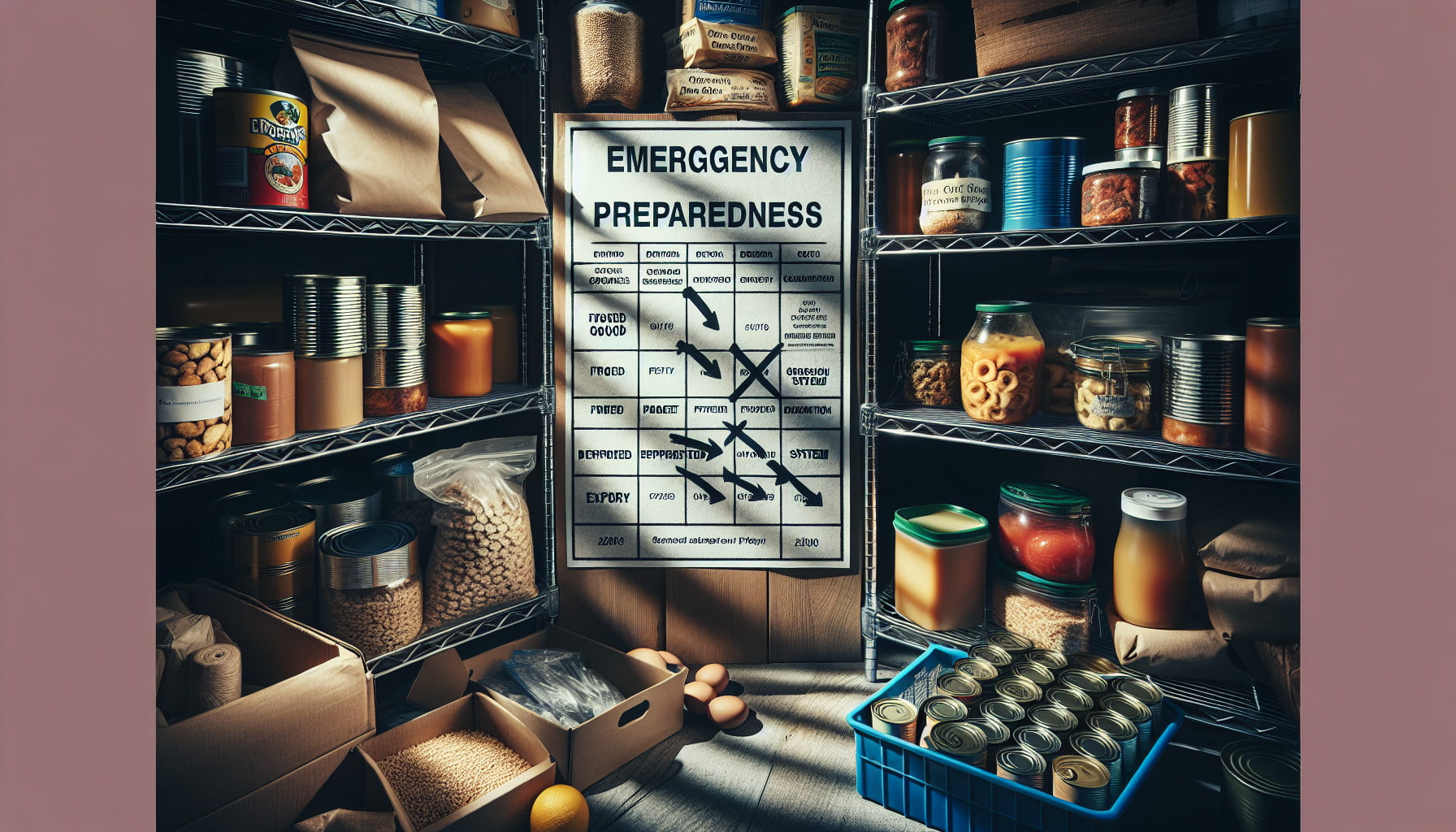So you’ve decided to take emergency preparedness seriously and you want to make sure you have enough food stocked up in case of an unexpected situation. But where do you start? With so many options and methods out there, it’s easy to get overwhelmed. In this article, we will explore some of the best ways to store food for emergency preparedness, covering everything from packaging and rotation to the types of foods that are best suited for long-term storage. Get ready to take notes, because being prepared never tasted so good!
1. Considerations for Emergency Food Storage
1.1 Shelf Life of Food
When it comes to emergency food storage, one of the most important factors to consider is the shelf life of the food. You want to make sure that the food you store will last for an extended period of time without spoiling or becoming inedible. Different types of foods have different shelf lives, so it’s essential to choose items with a long shelf life.
1.2 Nutritional Requirements
In times of emergency, it’s crucial to maintain proper nutrition to keep your body healthy and functioning optimally. When selecting food for your emergency storage, be sure to consider your nutritional requirements. Look for foods that provide a balance of essential nutrients, vitamins, and minerals to meet your body’s needs during a crisis.
1.3 Dietary Restrictions and Allergies
If you or someone in your household has special dietary restrictions or food allergies, it’s essential to take those into account when stocking up on emergency food. Look for options that accommodate those dietary needs, such as gluten-free or dairy-free products. Always read the labels carefully and choose food items that are safe for everyone in your family.
1.4 Storage Space
Consider the amount of storage space you have available when selecting food for emergency storage. Depending on your living situation, you may have limited space to store large quantities of food. Opt for compact and efficiently packaged items that can be easily stacked or stored in tight spaces to make the most of your storage area.
1.5 Cost
Emergency food storage can be a significant investment, so it’s essential to consider the cost when selecting items. Strike a balance between high-quality, long-lasting food and affordable options. Compare prices and explore different brands to find the best value for your budget. Remember, it’s essential to prioritize the quality and longevity of the food over cost alone.
1.6 Ease of Preparation
During an emergency, time and resources may be limited, so it’s important to consider the ease of preparation when choosing foods for your emergency storage. Look for items that require minimal cooking or preparation, such as ready-to-eat meals or canned goods. Having easily accessible and quick-to-prepare food options can provide a sense of convenience and practicality in emergency situations.
2. Stocking Up on Non-Perishable Foods
2.1 Canned Goods
Canned goods are a staple when it comes to emergency food storage. These items have a long shelf life, often lasting for several years. They also come in a wide variety of options, including soups, vegetables, fruits, and meats. Canned goods are convenient because they can be consumed directly from the can, requiring little to no preparation.
2.2 Dried Foods
Dried foods, such as beans, rice, pasta, and dried fruits, are excellent options for emergency food storage. These items have extended shelf lives and can be easily stored in airtight containers. Dried food can be cooked with minimal effort, requiring only water and heat. They provide a good source of carbohydrates and can be a valuable addition to a well-rounded emergency food stockpile.
2.3 Freeze-Dried and Dehydrated Foods
Freeze-dried and dehydrated foods are popular choices for emergency food storage due to their long shelf life and light weight. These foods undergo a preservation process that removes moisture while preserving their nutritional value. They can be rehydrated by adding water, making them convenient and easy to prepare in emergency situations.
2.4 Ready-to-Eat Meals
Ready-to-eat meals, often referred to as MREs (Meals Ready to Eat), are specially packaged meals designed for emergency situations. These meals are pre-cooked and require no preparation, making them ideal for emergencies where cooking facilities may be limited. They come in various flavors and contain a balanced combination of proteins, carbohydrates, and fats to provide the necessary nutrients during stressful times.
2.5 Pasta, Rice, and Grains
Pasta, rice, and grains are versatile and economical options for emergency food storage. They have long shelf lives and can be easily stored in airtight containers. These staples provide a good source of energy and are a great addition to any emergency food stockpile. They can be cooked in a variety of ways and used as a base for many different meals.
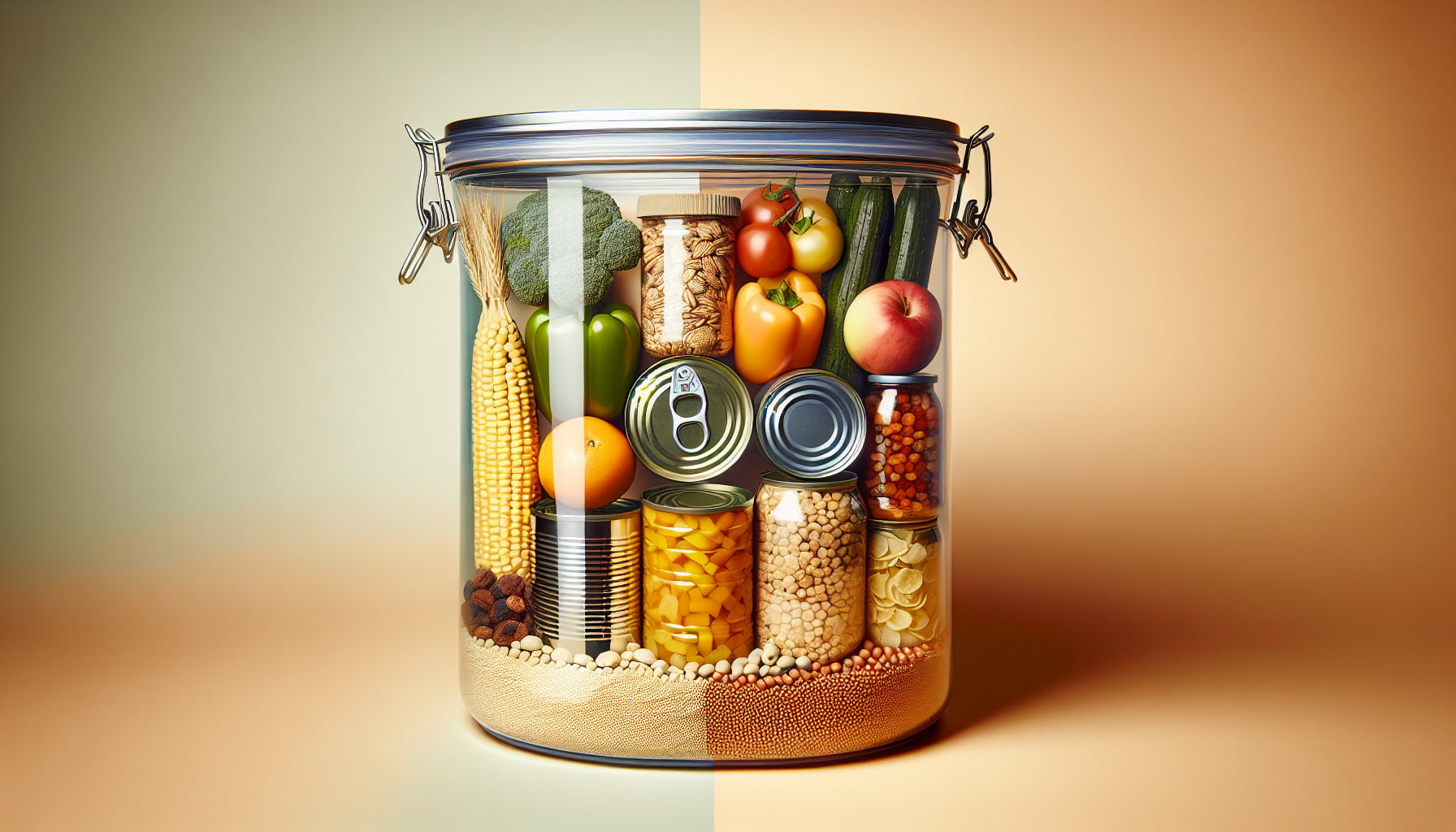
3. Proper Food Storage Containers
3.1 Airtight Containers
Using airtight containers is essential for maintaining the freshness and quality of your emergency food storage. These containers prevent moisture, air, and pests from entering and spoiling your food. Choose containers made from food-grade materials, such as BPA-free plastics or glass, to ensure the safety of your stored food.
3.2 Mylar Bags
Mylar bags are another popular choice for long-term food storage. These bags are made of a durable and flexible material that provides an additional barrier against moisture and air. They are often used in conjunction with oxygen absorbers to create an oxygen-free environment, further extending the shelf life of the stored food.
3.3 Mason Jars
Mason jars are a classic choice for food storage. They are made of glass and have an airtight seal when properly closed with their screw-on lids. Mason jars are ideal for storing dried goods, such as beans, rice, or pasta. They are also reusable and can be easily cleaned and sanitized for future use.
3.4 Food-grade Buckets
Food-grade buckets with airtight lids are an excellent option for storing larger quantities of food. These buckets are specifically designed to meet food safety standards and keep your emergency food free from contaminants. They are durable, stackable, and provide a generous storage capacity for bulk items like grains, flour, or dehydrated foods.
3.5 Vacuum Sealed Bags
Vacuum-sealed bags are an effective way to remove air from your food storage containers, maximizing the shelf life of the stored items. These bags can be used with a vacuum sealer to create a tight seal, preventing oxygen and moisture from reaching the food. Vacuum-sealed bags are commonly used for freezing food and can also be used for storing dried goods.
4. Creating a Rotation System
4.1 First-In, First-Out (FIFO) Method
To ensure that your emergency food supply remains fresh and consumable, it’s important to implement a rotation system. The first-in, first-out (FIFO) method involves using the oldest stored food first before moving on to newer items. This system prevents food from sitting unused for too long and helps maintain the quality of your stockpile.
4.2 Labeling and Date Tracking
Labeling and date tracking are crucial components of a rotation system. Use permanent markers or labels to mark the purchase or expiration dates on the containers or packaging. This practice allows you to easily identify the age of each item in your storage and prioritize the use of older products to avoid food waste.
4.3 Regularly Checking and Updating Inventory
Regularly check your emergency food inventory to ensure that it remains well-stocked and up to date. Create a schedule that works for you, whether it’s monthly, biannually, or annually, to review your stockpile. During these check-ins, take note of any expired or soon-to-expire items and make a plan to replace or consume them as necessary.
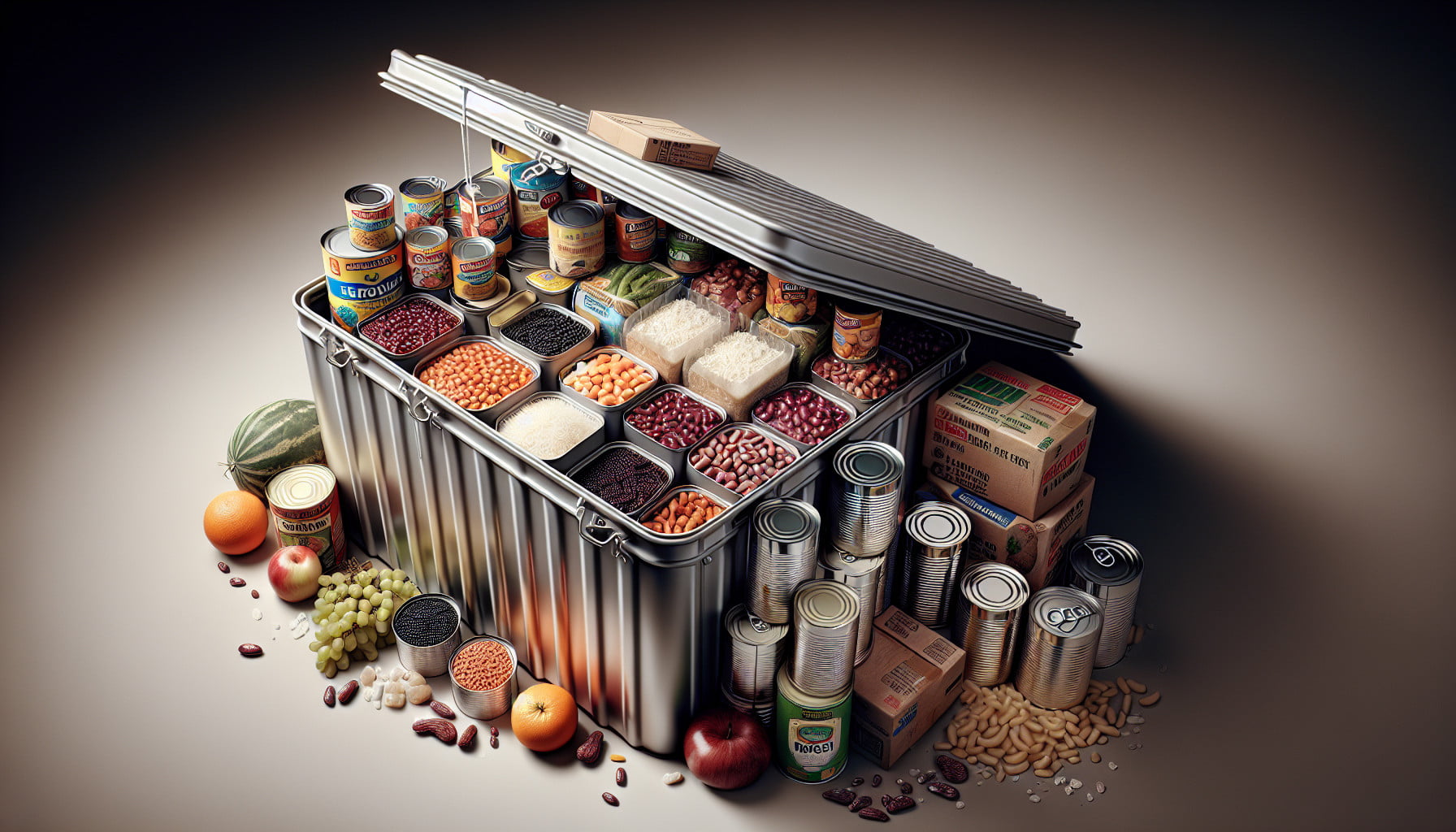
5. Ideal Storage Conditions
5.1 Cool and Dry Environment
When storing emergency food, it’s important to find a cool and dry environment. High temperatures can accelerate the degradation of food, while excessive moisture can promote the growth of mold and bacteria. Aim for a storage area with a relatively stable temperature, preferably below 75°F (24°C), and low humidity to maintain the quality of your stored food.
5.2 Temperature and Humidity Control
If possible, create a storage area with temperature and humidity control to optimize the conditions for your emergency food. Consider utilizing basement areas or dedicated storage rooms that can be regulated with air conditioning or dehumidifiers. By controlling the temperature and humidity, you can significantly extend the shelf life of your stored food.
5.3 Protection from Light and Pests
Protecting your emergency food from light exposure and pests is essential for maintaining its quality and safety. Store your food in opaque containers or in areas that are shielded from direct sunlight to prevent light-induced degradation. Additionally, take measures to prevent pests, such as rodents or insects, from accessing your food storage area by using traps, repellents, or proper sealing methods.
5.4 Avoiding Extreme Temperatures
Extreme temperatures, both hot and cold, can negatively impact the shelf life of stored food. Avoid storing your emergency food in areas that experience extreme temperature fluctuations, such as garages or sheds. Freezing temperatures can cause food to thaw and spoil, while extreme heat can accelerate the breakdown of nutrients and overall food quality.
6. Using Food Preservation Methods
6.1 Canning
Canning is a popular food preservation method that involves placing food in jars or cans and heating them to kill microorganisms, then sealing them to create an airtight environment. This method effectively preserves food for long periods, allowing you to enjoy garden-fresh produce even during emergencies. It’s important to follow proper canning techniques and ensure that your equipment and jars are in good condition for optimal results.
6.2 Dehydrating
Dehydrating is the process of removing moisture from food, extending its shelf life significantly. This method can be done using a dehydrator or by air-drying. Dehydrated foods are lightweight, compact, and great for emergency storage. Fruits, vegetables, and even meats can be dehydrated and rehydrated later when needed.
6.3 Freezing
Freezing is a simple and effective way to preserve food for longer periods. Many foods can be frozen, including fruits, vegetables, meats, and bread. By packaging your food in airtight freezer bags or containers, you can maintain the quality and nutrition of the food for months, if not longer. However, it’s important to have a backup power source or alternative freezer storage plan in case of a power outage.
6.4 Fermenting
Fermentation is a preservation method that involves the breakdown of carbohydrates in food by microorganisms, resulting in the production of acids, alcohol, and gases. Fermented foods, such as sauerkraut, kimchi, and pickles, have a long shelf life and offer numerous health benefits. You can ferment vegetables, fruits, and even dairy products, creating a valuable addition to your emergency food supply.
6.5 Pickling
Pickling is a preservation method that involves submerging food in an acidic solution, such as vinegar, salt, or brine. This process preserves the food by inhibiting the growth of bacteria, molds, and yeasts. Pickled foods, like cucumbers, beets, or peppers, can be stored for extended periods, providing a tangy and flavorful addition to your emergency food options.
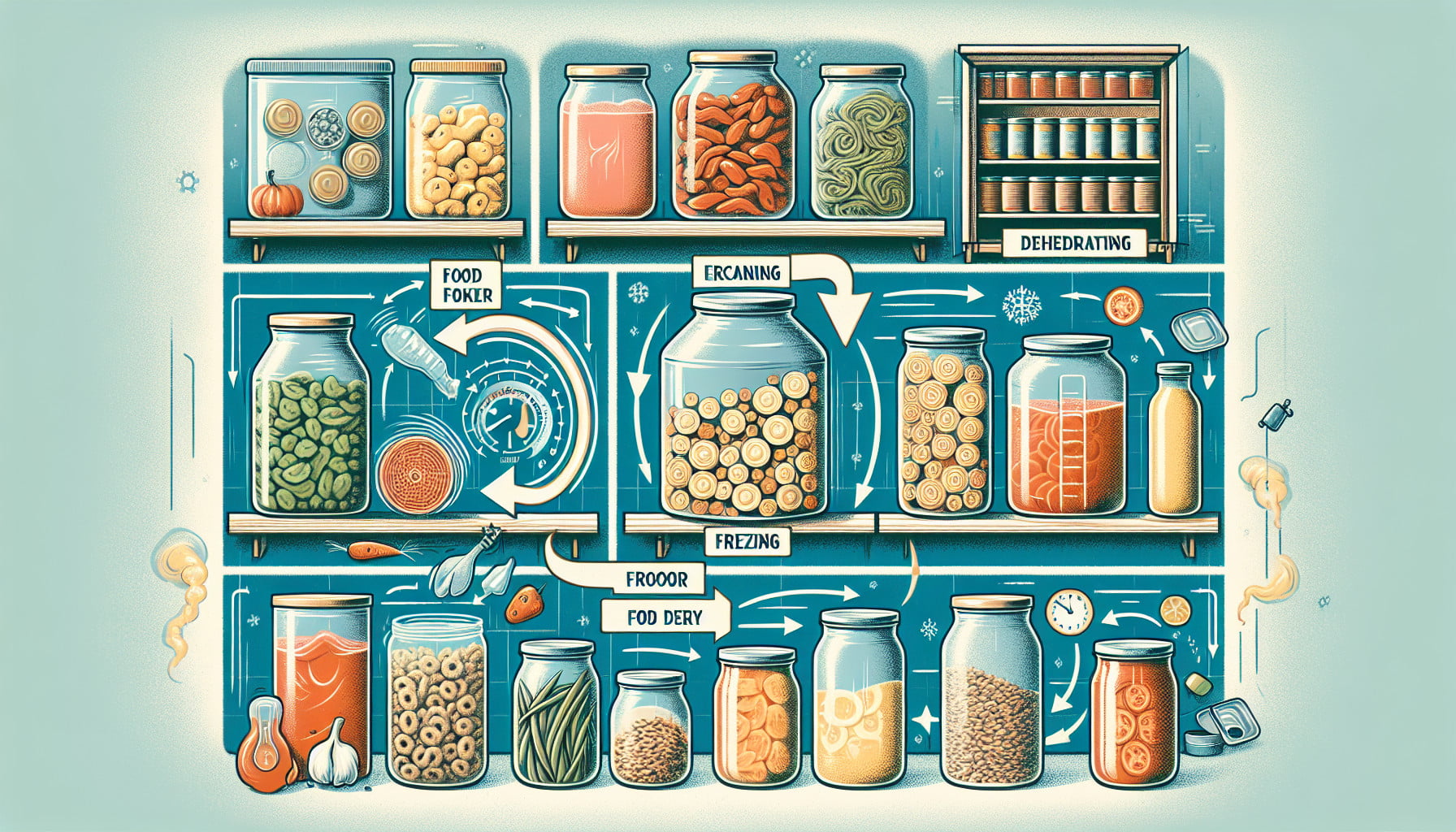
7. Emergency Water Storage
7.1 Water Needs
Water is one of the most critical elements of emergency preparedness. It’s important to understand and calculate your water needs to ensure you have an adequate supply for drinking, cooking, and sanitation. The general rule of thumb is to store at least one gallon (3.78 liters) of water per person per day for a minimum of three days. However, it’s recommended to store additional water for longer emergencies or situations where access to clean water is limited.
7.2 Safe Storage Containers
When storing water for emergencies, it’s crucial to use safe and clean containers to prevent contamination. Consider using food-grade plastic containers or glass bottles specifically designed for storing water. Avoid using containers that previously held chemicals or non-food substances, as these can contaminate the water.
7.3 Water Purification Methods
In addition to storing water, it’s important to have water purification methods on hand in case your supply becomes compromised. Methods such as boiling, using water filters, or using water purification tablets can help make water safe for consumption. Familiarize yourself with these purification methods and ensure you have the necessary equipment or supplies in your emergency kit.
8. Supplementing with Vitamins and Minerals
8.1 Importance of Nutrient Supplements
During emergencies, access to fresh fruits, vegetables, and other nutrient-rich foods may be limited. To ensure you’re meeting your nutritional needs, consider adding vitamin and mineral supplements to your emergency food storage. These supplements can help bridge the nutritional gaps and support your overall health during challenging times.
8.2 Long Shelf Life Supplements
When selecting supplements for your emergency food supply, look for options with a long shelf life. Some supplements, such as multivitamins, vitamin C, and vitamin D, are known for their stability and can last for several years if stored properly. Pay attention to expiration dates and consider rotating your supplements regularly to maintain their effectiveness.
8.3 Proper Storage of Supplements
To ensure the longevity and effectiveness of your supplements, it’s important to store them properly. Keep them in a cool, dry place away from direct sunlight, as exposure to heat and light can degrade their potency. Additionally, it’s wise to store them in airtight containers or packaging to protect them from moisture and air.
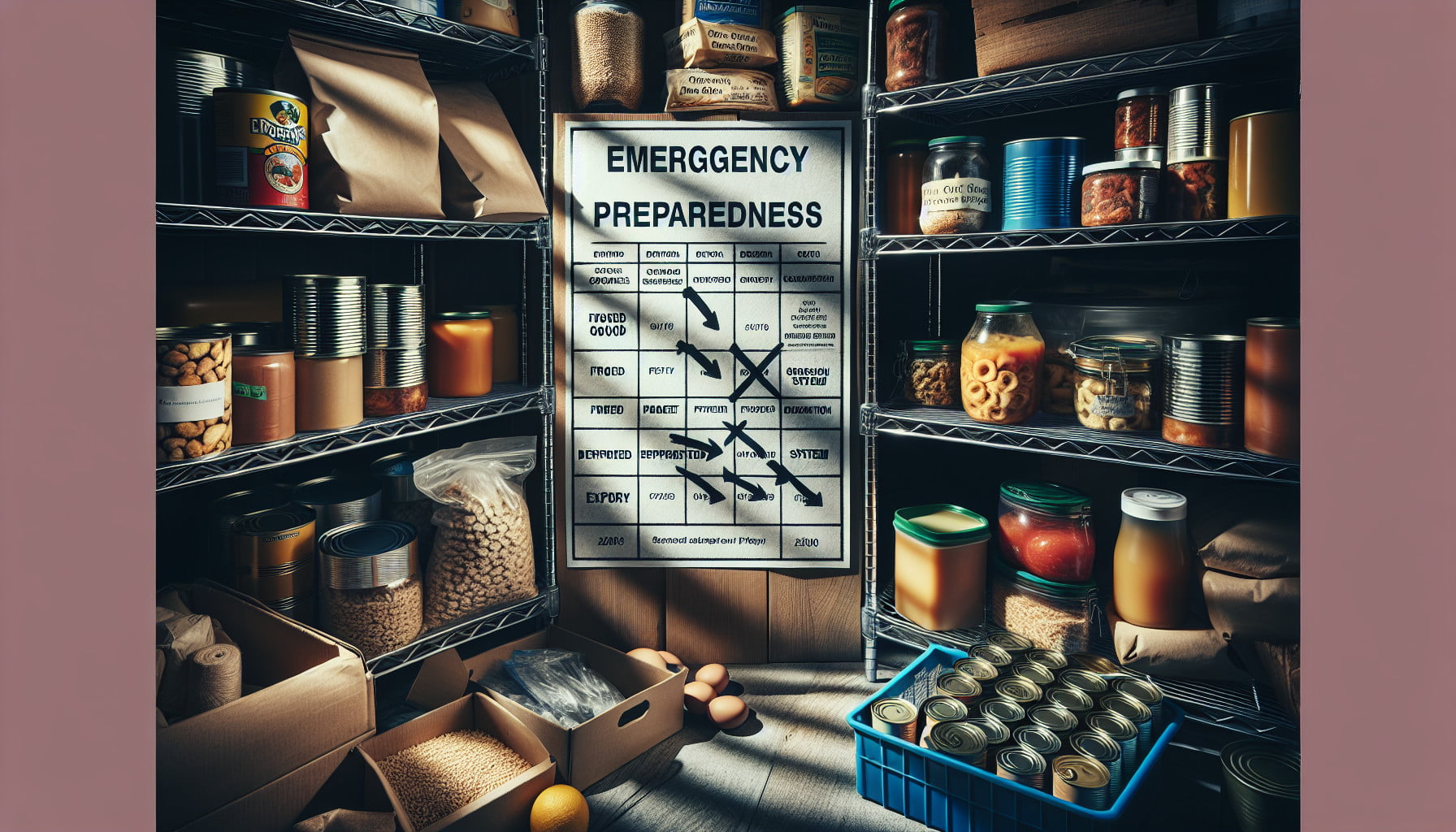
9. Considerations for Special Diets
9.1 Gluten-Free
For individuals with gluten allergies or sensitivities, it’s crucial to consider gluten-free options when stocking up on emergency food. Look for items labeled as gluten-free or choose naturally gluten-free foods like rice, potatoes, and quinoa. Ensure that any packaged items or ready-to-eat meals are certified gluten-free to avoid cross-contamination.
9.2 Vegetarian and Vegan
If you follow a vegetarian or vegan diet, incorporating plant-based options into your emergency food storage is essential. Look for canned or dehydrated plant protein sources, such as beans, lentils, and tofu. Stock up on fruits, vegetables, and whole grains to ensure you have a variety of nutrient-rich options during an emergency.
9.3 Nut and Dairy Allergies
For individuals with nut or dairy allergies, it’s important to be vigilant when selecting foods for emergency storage. Read labels carefully and choose items that are explicitly labeled as nut-free or dairy-free. Opt for alternatives like seed butter, coconut milk, or soy-based products to ensure you have safe and suitable options available during an emergency.
9.4 Diabetic-Friendly
For individuals with diabetes or blood sugar management requirements, it’s crucial to consider diabetic-friendly options when stockpiling food for emergencies. Look for low glycemic index foods, such as whole grains, legumes, and non-starchy vegetables. Avoid sugary or processed foods and focus on nutrient-dense choices that won’t cause spikes in blood sugar levels.
10. Maintaining Emergency Food Stockpile
10.1 Regularly Rotating Food
To ensure the freshness and quality of your emergency food stockpile, it’s important to regularly rotate your stored food. Implement the first-in, first-out (FIFO) method and consume or donate older items before they reach their expiration dates. By rotating your stock, you’ll minimize food waste and ensure that your supply is always fresh and safe to consume.
10.2 Monitoring Expiration Dates
Keep a close eye on the expiration dates of the food items in your emergency storage. Make it a habit to check the dates regularly and prioritize the consumption of items that are nearing expiration. Consider incorporating these items into your regular meal planning to ensure they are used before they become unusable.
10.3 Replacing and Restocking
As you consume or donate food from your emergency stockpile, make a point to restock those items to maintain a well-rounded inventory. Regularly assess your stored food and create a shopping list to replenish the items that have been used or will expire soon. Establish a schedule to assess your needs and restock accordingly.
10.4 Donating Excess Food
If you find yourself with excess food in your emergency stockpile, consider donating it to those in need. Local food banks, shelters, or community organizations often accept non-perishable food donations. By sharing your surplus with others, you can contribute to the well-being of your community and ensure that food doesn’t go to waste.
In conclusion, storing food for emergency preparedness requires careful consideration of factors such as shelf life, nutritional requirements, dietary restrictions, storage space, cost, and ease of preparation. Stocking up on non-perishable foods like canned goods, dried foods, and ready-to-eat meals can ensure a well-rounded emergency food supply. Choosing proper food storage containers, implementing a rotation system, and creating ideal storage conditions are essential for maintaining the quality and longevity of stored food. Exploring food preservation methods, paying attention to special diets, and addressing water storage and supplementation needs are also important aspects of comprehensive emergency food preparedness. By following these guidelines and continually monitoring and maintaining your supply, you can be better prepared for unexpected situations and ensure the well-being of yourself and your loved ones.

